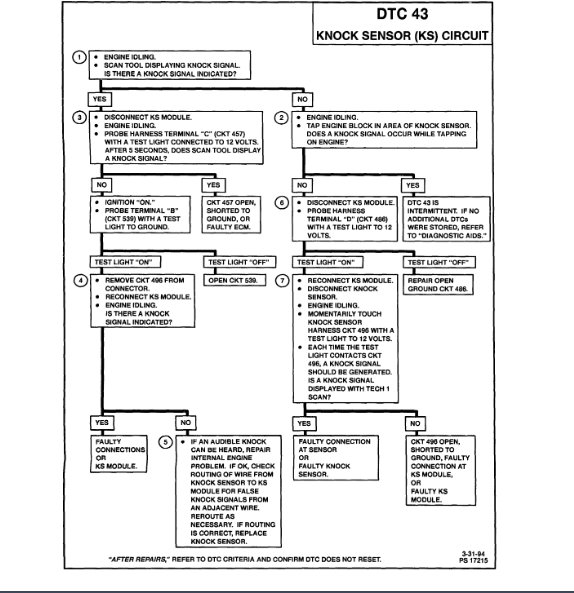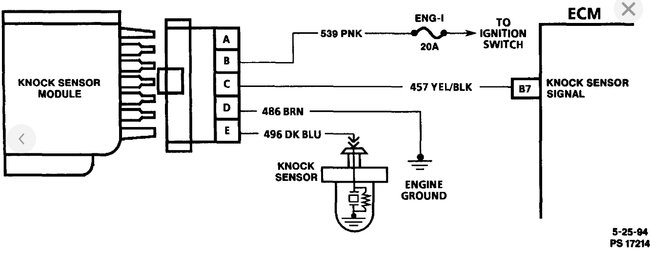Good morning,
Code 43 is for the knock sensor circuit, not ESC.
I attached a description below and a flow chart for determining the failure. The module is a common failure on the intake manifold.
Roy
CIRCUIT DESCRIPTION
Knock Sensor (KS) system is accomplished with a module which sends a voltage signal to the ECM. As the KS detects engine knock, the voltage from the KS module to the KS drops, which in turn signals the ECM to retard timing. The ECM will retard the timing when knock is detected and rpm is above 900 rpm but less than 3800 rpm.
DTC 43 WILL SET WHEN
DTC 43 means the ECM has seen a low voltage on CKT 457 terminal "B7" for longer than 5 seconds with the engine running, or the system has failed the functional check. The ECM continually monitors voltage on CKT 457 terminal "B7" if a knock signal (low voltage) is detected. But less than one second, the KS system is considered operational and DTC 43 will not set. If however, low voltage is detected for more than one second or signal voltage remains high, a functional check will be performed. To perform check, the ECM will advance the spark timing when coolant temperature is between 86°C-105°C (186°F-224°F) and the engine is under heavy load (near WOT). The ECM then checks the signal voltage at "B7" to see if a knock is detected. If no knock is detected, the MIL will remain "ON" until the ignition is turned "OFF" or until a knock signal is detected. The functional check will only be performed once per start-up.
ACTION TAKEN ECM WILL DEFAULT TO)
The Malfunction Indicator Lamp (MIL) will illuminate.
DTC 43 WILL CLEAR WHEN
Conditions for fault are no longer present and Tech 1 "Clear DTCs" function is used or 50 ignition switch keycycles have passed with no further faults or ignition switch is turned "OFF" and battery feed voltage is removed for 10 seconds.
DTC CHART TEST DESCRIPTION
Number(s) below refer to circled number(s) on the diagnostic chart.
1. If the conditions for a DTC 43 are present, the Tech 1 scan tool will always display "YES." There should not be a knock at idle unless an internal engine problem, or a system problem exists.
2. This test will determine if the system is functioning at this time. Usually a knock signal can be generated by tapping on the right exhaust manifold. If no knock signal is generated, try tapping on block close to the area of the sensor.
3. Because DTC 43 sets when the signal voltage on CKT 457 remains low, this test should cause the signal on CKT 457 to go high. The 12 volts signal should be seen by the ECM as "no knock" if the ECM and wiring are OK.
4. This test will determine if the knock signal is being detected on CKT 496 or if the KS module is at fault.
5. If CKT 496 is routed too close to secondary ignition wires, the KS module may see the interference as a knock signal.
6. This checks the ground circuit to the module. An open ground will cause the voltage on CKT 457 to be about 12 volts which would cause the DTC 43 functional test to fail.
7. Connecting CKT 496 with a test light to 12 volts should generate a knock signal. This will determine if the KS module is operating correctly.
DIAGNOSTIC AIDS
DTC 43 can be caused by a faulty connection at the knock sensor at the KS module or at the ECM. Also check CKT 457 for possible open or short to ground.
Refer to Diagnosis By Symptom / Intermittent See: Computers and Control Systems > Initial Inspection and Diagnostic Overview > - Intermittent Malfunctions
Images (Click to make bigger)
Sunday, January 13th, 2019 AT 8:06 AM

